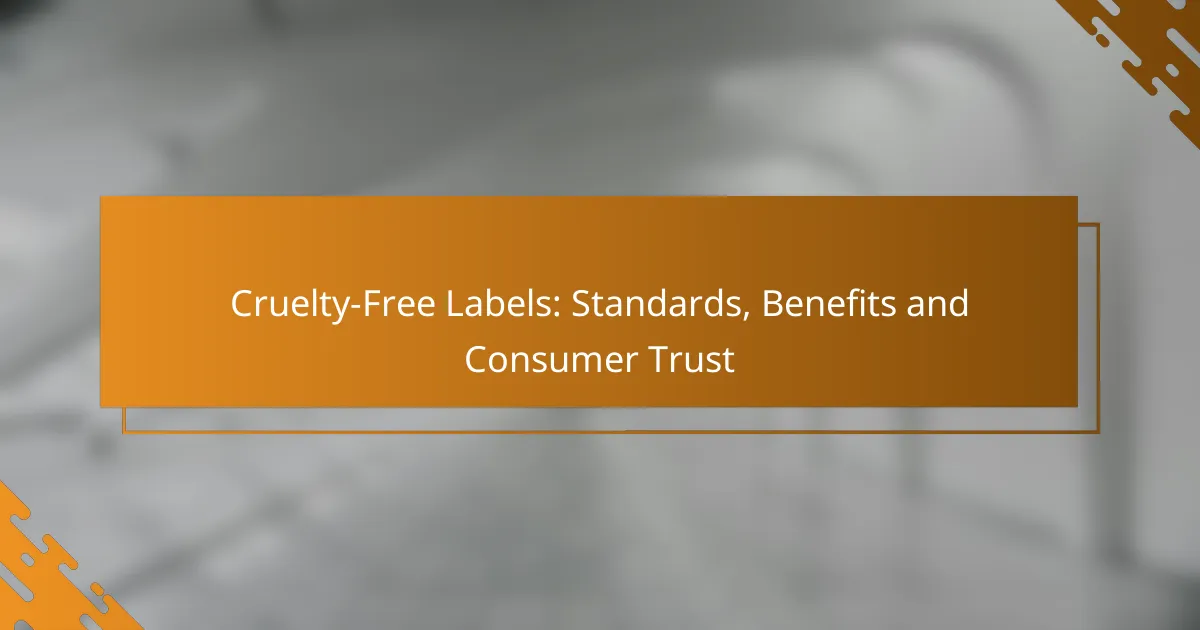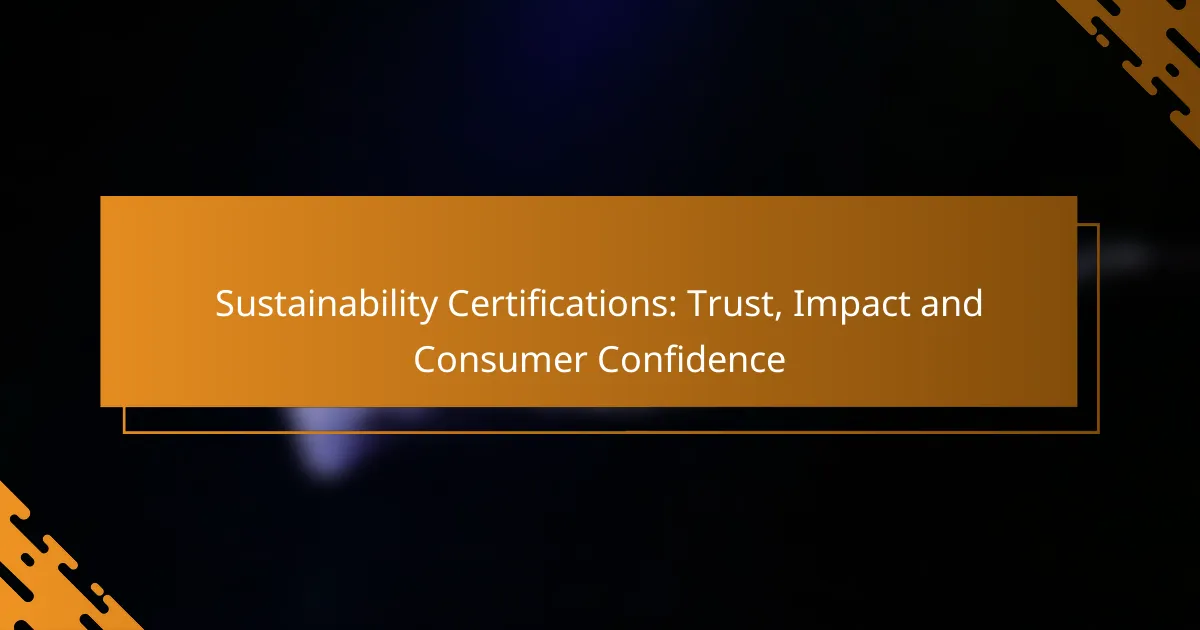Cruelty-free labels play a crucial role in helping consumers identify products that are not tested on animals, fostering trust and guiding ethical purchasing decisions. However, the standards for these labels can vary significantly among brands, leading to inconsistencies in their definitions of cruelty-free. As consumers become more conscious of ethical considerations and sustainability, the demand for cruelty-free products continues to rise, highlighting their benefits for both health and the environment.

What are the key cruelty-free labels in the USA?
In the USA, several key cruelty-free labels help consumers identify products that are not tested on animals. Understanding these labels can enhance consumer trust and guide ethical purchasing decisions.
Leaping Bunny
The Leaping Bunny certification is one of the most recognized cruelty-free labels in the USA. It signifies that a brand has met strict criteria regarding animal testing, including a commitment to not testing on animals at any stage of product development.
To obtain this certification, companies must undergo a rigorous application process and provide documentation of their animal testing policies. Brands with this label often display the Leaping Bunny logo prominently on their packaging, making it easy for consumers to identify them.
Certified Vegan
The Certified Vegan label indicates that a product is free from animal-derived ingredients and has not been tested on animals. This label is particularly important for consumers who prioritize both cruelty-free practices and veganism.
Brands seeking this certification must ensure that their products contain no animal ingredients and are not tested on animals. This label is a strong indicator of a brand’s commitment to ethical practices, appealing to a growing market of conscious consumers.
PETA’s Beauty Without Bunnies
PETA’s Beauty Without Bunnies program provides a cruelty-free certification for brands that do not test on animals. This label is widely recognized and helps consumers identify products that align with their values regarding animal welfare.
To be listed in the Beauty Without Bunnies database, brands must complete a questionnaire confirming their animal testing policies. The program also includes a commitment to not sell products in markets where animal testing is required by law, further reinforcing their cruelty-free stance.
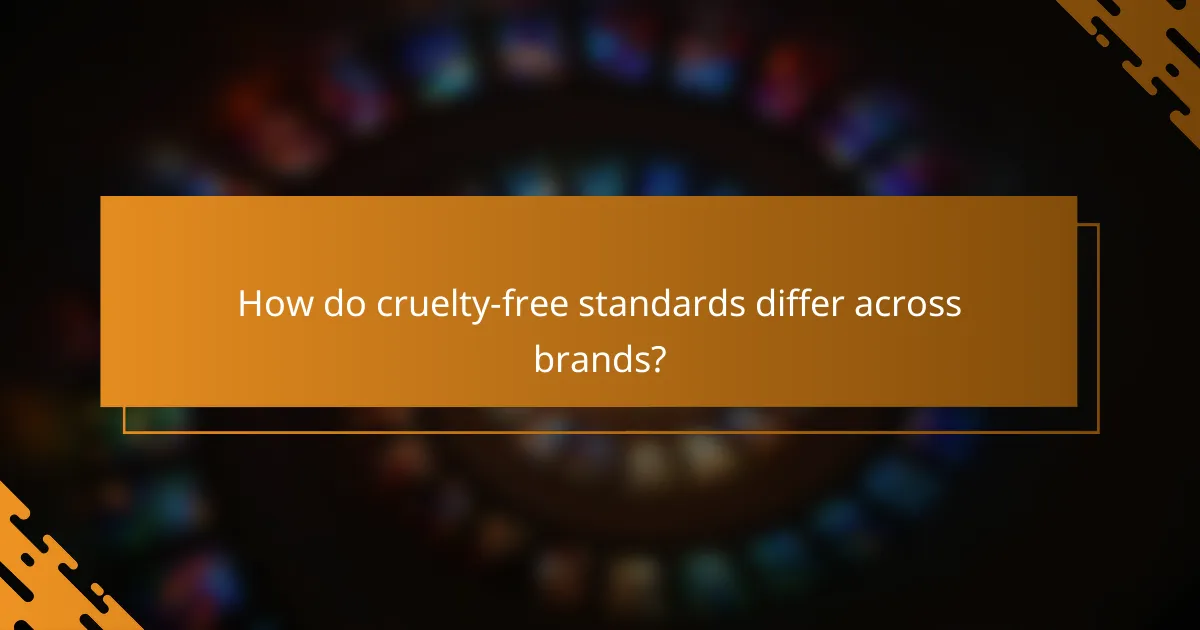
How do cruelty-free standards differ across brands?
Cruelty-free standards vary significantly among brands, primarily based on their specific policies and the certifications they choose to pursue. Some brands may adhere to strict no-animal-testing policies, while others might allow certain exceptions, leading to inconsistencies in what cruelty-free means across the market.
Brand-specific criteria
Each brand defines its cruelty-free criteria, which can include commitments to avoid animal testing at all stages of product development. Some brands may also consider the sourcing of ingredients, ensuring that suppliers do not engage in animal testing. It’s essential for consumers to research individual brands to understand their specific practices and claims.
For example, a brand might state that it does not test finished products on animals, but it could still source ingredients from suppliers that do. Therefore, looking for transparency in ingredient sourcing is crucial when evaluating a brand’s cruelty-free status.
Third-party certifications
Third-party certifications provide a standardized way to verify a brand’s cruelty-free claims. Organizations like Leaping Bunny and PETA offer certifications that require brands to meet specific criteria and undergo regular audits. These certifications help consumers identify products that align with their ethical values.
When shopping, look for products that display these certifications prominently on their packaging. This can simplify the decision-making process, as certified brands are more likely to adhere to stringent cruelty-free standards. However, not all cruelty-free brands seek certification, so it’s still important to investigate their policies directly.

What are the benefits of cruelty-free products?
Cruelty-free products offer several advantages, including ethical considerations, potential health benefits, and a positive environmental impact. Consumers increasingly prefer these products as they align with humane values and sustainable practices.
Ethical consumerism
Choosing cruelty-free products supports ethical consumerism by promoting the humane treatment of animals in the beauty and personal care industries. This choice reflects a commitment to social responsibility, encouraging brands to adopt more compassionate practices.
As awareness grows, many consumers actively seek out cruelty-free certifications, such as Leaping Bunny or PETA’s cruelty-free logo. These labels help shoppers identify products that do not involve animal testing, fostering a market that prioritizes ethical standards.
Health benefits
Cruelty-free products often contain fewer harmful chemicals, as brands that prioritize animal welfare may also focus on using safer, more natural ingredients. This can lead to healthier options for consumers, particularly those with sensitive skin or allergies.
Additionally, many cruelty-free brands are vegan, meaning they avoid animal-derived ingredients. This shift can benefit consumers looking for plant-based alternatives that are less likely to irritate the skin or cause adverse reactions.
Environmental impact
Many cruelty-free brands emphasize sustainable sourcing and eco-friendly practices, contributing to a reduced environmental footprint. By choosing these products, consumers can support companies that prioritize renewable resources and minimize waste.
For instance, cruelty-free brands may use recyclable packaging or adopt cruelty-free testing methods that do not harm the environment. This approach aligns with broader sustainability goals, making it easier for consumers to make environmentally conscious choices.
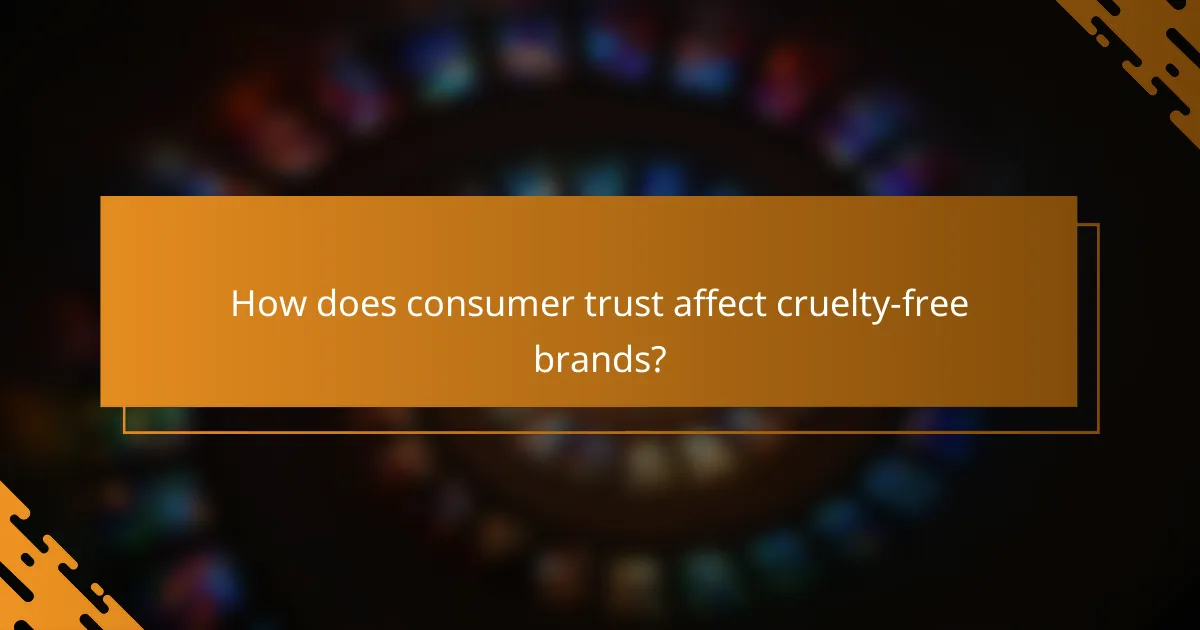
How does consumer trust affect cruelty-free brands?
Consumer trust is crucial for cruelty-free brands as it directly influences purchasing decisions and brand reputation. When consumers believe in a brand’s commitment to ethical practices, they are more likely to choose its products over competitors.
Transparency in sourcing
Transparency in sourcing is essential for building consumer trust in cruelty-free brands. Brands that openly share information about their supply chains, ingredient sourcing, and testing methods demonstrate accountability and integrity. For instance, companies that provide detailed reports on their cruelty-free certifications and sourcing practices can enhance consumer confidence.
To ensure transparency, brands can adopt third-party certifications from recognized organizations, such as Leaping Bunny or PETA. These certifications help consumers easily identify products that meet cruelty-free standards, fostering trust and loyalty.
Brand loyalty
Brand loyalty is significantly influenced by consumer trust in cruelty-free practices. When customers feel assured that a brand aligns with their ethical values, they are more likely to remain loyal and make repeat purchases. This loyalty can translate into long-term profitability for cruelty-free brands.
To cultivate brand loyalty, companies should engage with their customers through social media, newsletters, and community initiatives. Regularly updating consumers on their cruelty-free efforts and responding to feedback can strengthen relationships and reinforce trust.
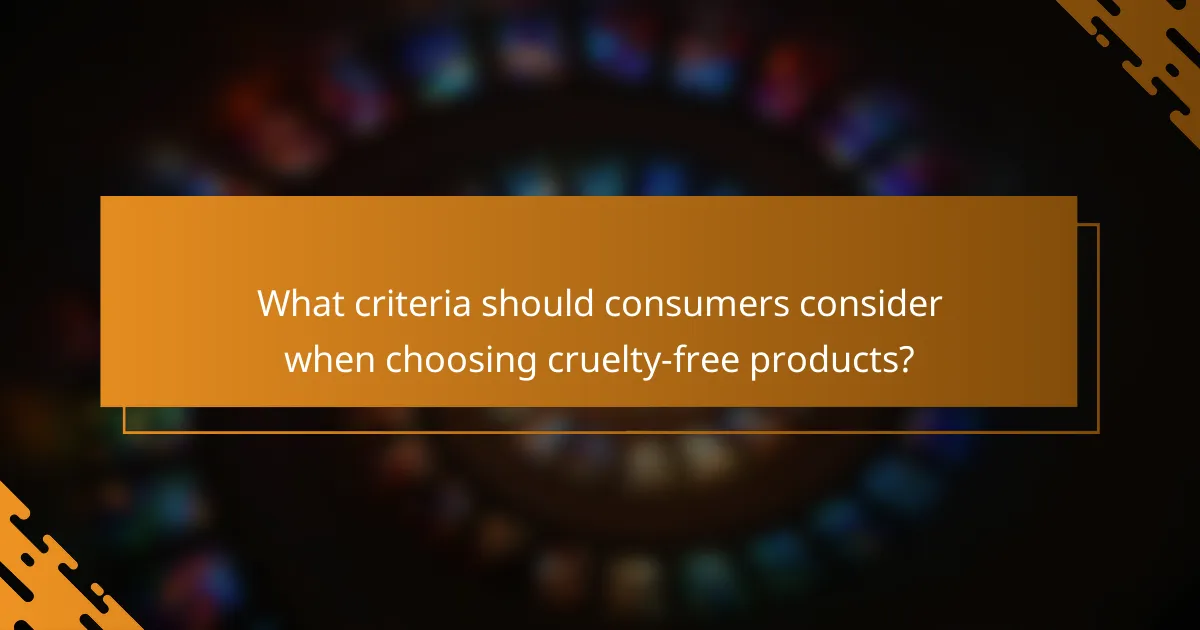
What criteria should consumers consider when choosing cruelty-free products?
When selecting cruelty-free products, consumers should prioritize certification authenticity and ingredient sourcing. These factors ensure that the products are genuinely free from animal testing and align with ethical standards.
Certification authenticity
Certification authenticity is crucial when determining if a product is truly cruelty-free. Look for recognized certifications from reputable organizations, such as Leaping Bunny or PETA’s Beauty Without Bunnies program. These certifications indicate that the brand adheres to strict guidelines against animal testing.
Be cautious of brands that make vague claims about being cruelty-free without third-party verification. Always check the label for specific certification logos to ensure the product meets established cruelty-free standards.
Ingredient sourcing
Ingredient sourcing plays a significant role in cruelty-free products. Brands should source ingredients from suppliers that do not conduct animal testing. Researching a brand’s supply chain can provide insights into their ethical practices.
Consider reaching out to companies directly to inquire about their ingredient sourcing policies. Transparency in sourcing can indicate a brand’s commitment to cruelty-free practices and help you make informed choices.
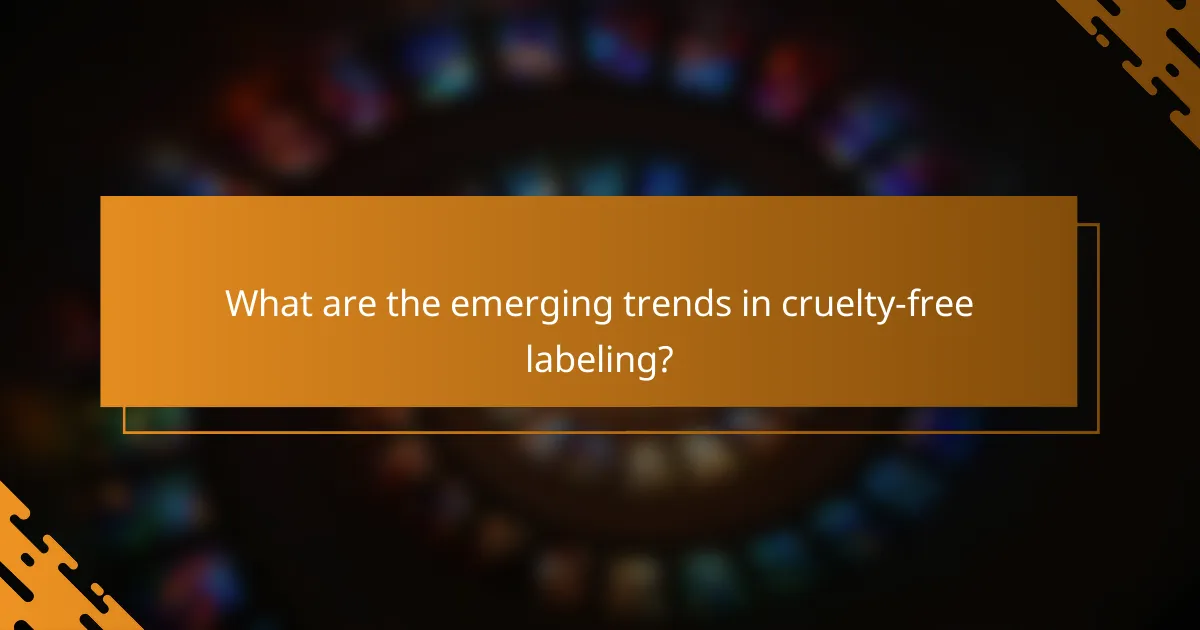
What are the emerging trends in cruelty-free labeling?
Emerging trends in cruelty-free labeling reflect a growing consumer demand for ethical products. As awareness increases, brands are adapting to meet expectations for transparency and accountability in their cruelty-free claims.
Increased demand for transparency
Consumers are increasingly seeking transparency regarding the sourcing and testing practices of beauty and personal care products. This demand has led brands to provide clearer information on their labels about cruelty-free practices, often detailing their testing methods and ingredient origins.
To cater to this trend, companies are adopting more straightforward labeling practices, ensuring that consumers can easily identify products that align with their ethical values. Brands that fail to provide adequate transparency risk losing customer trust and loyalty.
Expansion of cruelty-free certifications
The number of cruelty-free certifications has significantly expanded, with various organizations offering their own standards. This proliferation allows consumers to choose from a wider range of certified products, but it can also create confusion regarding which certifications are the most credible.
Popular certifications include Leaping Bunny and PETA’s Beauty Without Bunnies, each with specific criteria for cruelty-free claims. Brands are encouraged to select certifications that best reflect their values and resonate with their target audience.
Global standardization efforts
There are ongoing efforts to establish global standards for cruelty-free labeling, aiming to unify the various certification processes across different regions. These initiatives seek to create a consistent framework that consumers can trust, regardless of where products are sold.
As countries adopt similar regulations, brands will benefit from clearer guidelines and reduced complexity in meeting cruelty-free standards. This standardization can enhance consumer confidence and streamline the purchasing process for ethically-minded shoppers.

How can consumers advocate for cruelty-free practices?
Consumers can advocate for cruelty-free practices by actively supporting brands that prioritize humane treatment of animals and participating in awareness campaigns. By making informed choices and voicing their preferences, individuals can influence companies to adopt cruelty-free policies.
Supporting cruelty-free brands
One of the most effective ways to advocate for cruelty-free practices is by purchasing products from brands that are certified cruelty-free. Look for labels from reputable organizations, such as Leaping Bunny or PETA, which ensure that no animal testing is involved in the production process. By choosing these brands, consumers send a clear message that there is a demand for ethical products.
Additionally, consider researching and sharing lists of cruelty-free brands with friends and family. This can help raise awareness and encourage others to make similar purchasing decisions. Many consumers are unaware of the impact their choices have on animal welfare, so education is key.
Engaging in social media campaigns
Social media is a powerful tool for advocating cruelty-free practices. By participating in campaigns that promote cruelty-free brands or share information about animal testing, consumers can amplify their voices and reach a wider audience. Use hashtags related to animal welfare and cruelty-free living to connect with like-minded individuals.
Consider creating or joining online petitions that call for companies to adopt cruelty-free policies. Engaging with brands directly through social media platforms can also be effective; tag them in posts expressing your support for their cruelty-free initiatives or ask them about their animal testing policies. This direct engagement can prompt companies to take consumer concerns seriously.
